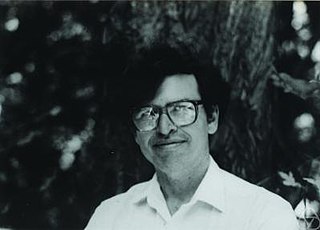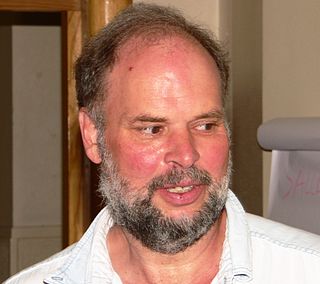Related Research Articles

William Paul Thurston was an American mathematician. He was a pioneer in the field of low-dimensional topology and was awarded the Fields Medal for his contributions to the study of 3-manifolds in 1982.

In knot theory, a figure-eight knot is the unique knot with a crossing number of four. This makes it the knot with the third-smallest possible crossing number, after the unknot and the trefoil knot. The figure-eight knot is a prime knot.

In the mathematical field of topology, knot theory is the study of mathematical knots. While inspired by knots which appear in daily life, such as those in shoelaces and rope, a mathematical knot differs in that the ends are joined so it cannot be undone, the simplest knot being a ring. In mathematical language, a knot is an embedding of a circle in 3-dimensional Euclidean space, . Two mathematical knots are equivalent if one can be transformed into the other via a deformation of upon itself ; these transformations correspond to manipulations of a knotted string that do not involve cutting it or passing through itself.

In the mathematical field of knot theory, a knot invariant is a quantity defined for each knot which is the same for equivalent knots. The equivalence is often given by ambient isotopy but can be given by homeomorphism. Some invariants are indeed numbers (algebraic), but invariants can range from the simple, such as a yes/no answer, to those as complex as a homology theory. Research on invariants is not only motivated by the basic problem of distinguishing one knot from another but also to understand fundamental properties of knots and their relations to other branches of mathematics. Knot invariants are thus used in knot classification, both in "enumeration" and "duplication removal".
A knot invariant is a quantity defined on the set of all knots, which takes the same value for any two equivalent knots. For example, a knot group is a knot invariant.
Typically a knot invariant is a combinatorial quantity defined on knot diagrams. Thus if two knot diagrams differ with respect to some knot invariant, they must represent different knots. However, as is generally the case with topological invariants, if two knot diagrams share the same values with respect to a [single] knot invariant, then we still cannot conclude that the knots are the same.

Sir Vaughan Frederick Randal Jones was a New Zealand mathematician known for his work on von Neumann algebras and knot polynomials. He was awarded a Fields Medal in 1990.

In mathematics, a hyperbolic manifold is a space where every point looks locally like hyperbolic space of some dimension. They are especially studied in dimensions 2 and 3, where they are called hyperbolic surfaces and hyperbolic 3-manifolds, respectively. In these dimensions, they are important because most manifolds can be made into a hyperbolic manifold by a homeomorphism. This is a consequence of the uniformization theorem for surfaces and the geometrization theorem for 3-manifolds proved by Perelman.

In knot theory, the Whitehead link, named for J. H. C. Whitehead, is one of the most basic links. It can be drawn as an alternating link with five crossings, from the overlay of a circle and a figure-eight shaped loop.

William Bernard Raymond Lickorish is a mathematician. He is emeritus professor of geometric topology in the Department of Pure Mathematics and Mathematical Statistics, University of Cambridge, and also an emeritus fellow of Pembroke College, Cambridge. His research interests include topology and knot theory. He was one of the discoverers of the HOMFLY polynomial invariant of links, and proved the Lickorish-Wallace theorem which states that all closed orientable 3-manifolds can be obtained by Dehn surgery on a link.

Marc Edward Culler is an American mathematician who works in geometric group theory and low-dimensional topology. A native Californian, Culler did his undergraduate work at the University of California at Santa Barbara and his graduate work at Berkeley where he graduated in 1978. He is now at the University of Illinois at Chicago. Culler is the son of Glen Jacob Culler who was an important early innovator in the development of the Internet.

Ioana Dumitriu is a Romanian-American mathematician who works as a professor of mathematics at the University of California, San Diego. Her research interests include the theory of random matrices, numerical analysis, scientific computing, and game theory.
Ana Caraiani is a Romanian-American mathematician, who is a Royal Society University Research Fellow and Professor of Pure Mathematics at Imperial College London. Her research interests include algebraic number theory and the Langlands program.

Marc Lackenby is a professor of mathematics at the University of Oxford whose research concerns knot theory, low-dimensional topology, and group theory.
The Alice T. Schafer Mathematics Prize is given annually to an undergraduate woman for excellence in mathematics by the Association for Women in Mathematics (AWM). The prize, which carries a monetary award, is named for former AWM president and founding member Alice T. Schafer; it was first awarded in 1990.
Efstratia (Effie) Kalfagianni is a Greek American mathematician specializing in low-dimensional topology.
Melody Tung Chan is an American mathematician and violinist who works as Associate Professor of Mathematics at Brown University. She is a winner of the Alice T. Schafer Prize and of the AWM–Microsoft Research Prize in Algebra and Number Theory. Her research involves combinatorial commutative algebra, graph theory, and tropical geometry.

Eugénie Lee Hunsicker is an American mathematician who works at Loughborough University in England as a senior lecturer in pure mathematics and as director of equality and diversity for the school of science. Her research in pure mathematics has concerned topics "at the intersection of analysis, geometry and topology"; she has also worked on more applied topics in data science and image classification.
Tara Elise Brendle is an American mathematician who works in geometric group theory, which involves the intersection of algebra and low-dimensional topology. In particular, she studies mapping class group of surfaces, including braid groups, and their relationship to automorphism groups of free groups and arithmetic groups. She is a professor of mathematics and head of mathematics at the University of Glasgow.
Elizabeth Lee Wilmer is an American mathematician known for her work on Markov chain mixing times. She is a professor, and former department head, of mathematics at Oberlin College.

Wei Ho is an American mathematician specializing in number theory, algebraic geometry, arithmetic geometry, and representation theory. She is an associate professor of mathematics at the University of Michigan in Ann Arbor, Michigan.
Ruth Alexandra Britto-Pacumio is an American mathematical physicist whose research topics include black holes, Yang–Mills theory, and the theory of Feynman integrals; with Freddy Cachazo, Bo Feng, and Edward Witten she is one of the namesakes of the BCFW recursion relations for computing scattering amplitudes. She is an associate professor in mathematics and theoretical physics at Trinity College Dublin, and is also affiliated with the Institut de Physique Théorique of CEA Saclay.
References
- 1 2 3 4 5 6 7 Curriculum vitae (PDF), Monash University, retrieved 2021-03-14
- ↑ Purcell, Jessica, Biography: Some frequently asked questions, Brigham Young University, retrieved 2021-03-14
- ↑ Alice T. Schafer Prize for Excellence in Mathematics by an Undergraduate Woman 1998, Association for Women in Mathematics, retrieved 2021-03-14
- ↑ Gallian, Joseph A. (June–July 2019), "The First Twenty-Five Winners of the AWM Alice T. Schafer Prize" (PDF), Notices of the American Mathematical Society, 66 (6): 870–874, doi: 10.1090/noti1892
- ↑ Jessica Purcell at the Mathematics Genealogy Project
- ↑ "Math Professor Jessica Purcell Wins Prestigious Fellowship", BYU News, Brigham Young University, 23 February 2011
- ↑ Past WIMSIG executive committees, Australian Mathematical Society, retrieved 2021-03-14
- ↑ Review of Hyperbolic Knot Theory: Henry Segerman , MAA Reviews
- ↑ Reviews of Guts of Surfaces and the Colored Jones Polynomial: Heather A. Dye, MR 3024600; Daniel Moskovich, Zbl 1270.57002